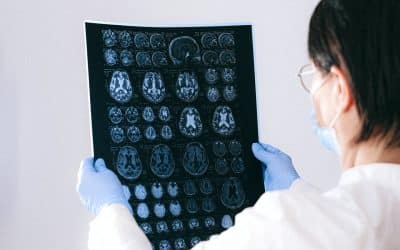Baseline sleep characteristics were explored for 71 U.S. military service members with mild traumatic brain injury (mTBI) enrolled in a post-concussive syndrome clinical trial. The Pittsburgh Sleep Quality Index (PSQI), sleep diary, several disorder-specific questionnaires, actigraphy and polysomnographic nap were collected. Almost all (97%) reported ongoing sleep problems. The mean global PSQI score was 13.5 (SD=3.8) and 87% met insomnia criteria. Sleep maintenance efficiency was 79.1% for PSQI, 82.7% for sleep diary and 90.5% for actigraphy; total sleep time was 288, 302 and 400 minutes, respectively. There was no correlation between actigraphy and subjective questionnaires. Overall, 70% met hypersomnia conditions, 70% were at high risk for obstructive sleep apnea (OSA), 32% were symptomatic for restless legs syndrome, and 6% reported cataplexy. Nearly half (44%) reported coexisting insomnia, hypersomnia and high OSA risk. Participants with post-traumatic stress disorder (PTSD) had higher PSQI scores and increased OSA risk. Older participants and those with higher aggression, anxiety or depression also had increased OSA risk. The results confirm poor sleep quality in mTBI with insomnia, hypersomnia, and OSA risk higher than previously reported, and imply sleep disorders in mTBI may be underdiagnosed or exacerbated by comorbid PTSD.
Concussion
Hyperbaric Oxygen Therapy (HBOT) Research for concussion.
Linear analysis of heart rate variability in post-concussive syndrome.
Heart rate variability (HRV) represents measurable output of coordinated structural and functional systems within the body and brain. Both mild traumatic brain injury (mTBI) and HRV are modulated by changes in autonomic nervous system function. We present baseline HRV results from an ongoing mTBI clinical trial. HRV was assessed via 24-hour ambulatory electrocardiography; recordings were segmented by physiological state (sleep, wakefulness, exercise, standing still). Time, frequency, and spatial domain measures were summarized and compared with symptoms, sleep quality, and neurological examination. Median low frequency/high frequency (LF/HF) ratio exceeded 1.0 across segments, indicating prevalence of sympathetic modulation. Abnormal Sharpened Romberg Test was associated with 29% LF/HF decrease (95% CI [2.1, 47.7], p=0.04); pathological nystagmus associated with decreased standard deviation of electrocardiogram R-R interval (SDNN) index (25% decrease, 95% CI [0.8, 43.4], p=0.04). Increased sympathetic modulation was associated with increased anger scores (19% LF/HF increase with 5-point State Trait Anger Expression Inventory-2 trait anger increase (95% CI [1.2, 39.1], p=0.04)). A 13% HF increase (95% CI [2.1, 25.7], p=0.02) was observed with increased Pittsburgh Sleep Quality Index scores. These results support autonomic nervous system dysfunction in service members after mTBI.
Neuropsychological assessments in a hyperbaric trial of post-concussive symptoms.
Results of studies addressing the effect of mild traumatic brain injury (mTBI) and post-traumatic stress disorder (PTSD) on symptoms and neuropsychological assessments are mixed regarding cognitive deficits in these populations. Neuropsychological assessments were compared between U.S. military service members with mTBI only (n=36) vs. those with mTBI÷ PTSD (n=35) from a randomized interventional study of mTBI participants with persistent post-concussive symptoms (PCS). The mTBI group endorsed worse symptoms than published norms on PCS, PTSD and pain scales (⟩50% abnormal on Neurobehavioral Symptom Inventory (NSI), PTSD Checklist-Civilian, McGill Pain Questionnaire-Short Form) and some quality of life domains. Worse symptom reporting was found in the mTBI÷ PTSD group compared to mTBI (e.g., mean NSI total score in mTBI 27.5 (SD=12.7), mTBI÷ PTSD 39.9 (SD=13.6), p⟨0.001). The mTBI÷PTSD group performed worse than mTBI on the Weschler Adult Intelligence Scale digit span (mean difference -1.5, 95% CI[-2.9,-0.1], p=0.04) and symbol search (mean difference -1.5, 95% CI[-2.7,-0.2], p=0.03) and Grooved Pegboard (dominant hand mean difference -7.0, 95% CI[-11.5,-2.4], p=0.003; non-dominant mean difference -9.8, 95% CI[-14.9,-4.7], p⟨0.001). Differences were detected in ANAM simple reaction time (p=0.04) and mathematical processing (p=0.03) but not verbal fluency or visuospatial memory assessments. Results indicate increased symptom severity and some cognitive deficits in mTBI÷ PTSD compared to mTBI alone.
Hyperbaric oxygen for mild traumatic brain injury: Design and baseline summary.
The Brain Injury and Mechanisms of Action of Hyperbaric Oxygen for Persistent Post-Concussive Symptoms after Mild Traumatic Brain Injury (mTBI) (BIMA) study, sponsored by the Department of Defense, is a randomized double-blind, sham-controlled clinical trial that has a longer duration of follow-up and more comprehensive assessment battery compared to recent HBO₂ studies. BIMA randomized 71 participants from September 2012 to May 2014. Primary results are expected in 2017. Randomized military personnel received hyperbaric oxygen (HBO₂) at 1.5 atmospheres absolute (ATA) or sham chamber sessions at 1.2 ATA, air, for 60 minutes daily for 40 sessions. Outcomes include neuropsychological, neuroimaging, neurological, vestibular, autonomic function, electroencephalography, and visual systems evaluated at baseline, immediately following intervention at 13 weeks and six months with self-report symptom and quality of life questionnaires at 12 months, 24 months and 36 months. Characteristics include: median age 33 years (range 21-53); 99% male; 82% Caucasian; 49% diagnosed post-traumatic stress disorder; 28% with most recent injury three months to one year prior to enrollment; 32% blast injuries; and 73% multiple injuries. This manuscript describes the study design, outcome assessment battery, and baseline characteristics. Independent of a therapeutic role of HBO₂, results of BIMA will aid understanding of mTBI.
Executive summary: The Brain Injury and Mechanism of Action of Hyperbaric Oxygen for Persistent Post-Concussive Symptoms after Mild Traumatic Brain Injury (mTBI) (BIMA) Study.
The Brain Injury and Mechanism of Action of Hyperbaric Oxygen for Persistent Post-Concussive Symptoms after Mild Traumatic Brain Injury (mTBI) (BIMA) study, sponsored by the Department of Defense and held under an investigational new drug application by the Office of the Army Surgeon General, is one of the largest and most complex clinical trials of hyperbaric oxygen (HBO₂) for post-concussive symptoms (PCS) in U.S. military service members.
Baseline EEG abnormalities in mild traumatic brain injury from the BIMA study.
The Brain Injury and Mechanisms of Action of HBO₂ for Persistent Post-Concussive Symptoms after Mild Traumatic Brain Injury (BIMA), sponsored by the Department of Defense, is a randomized, double-blind, sham-controlled trial of hyperbaric oxygen (HBO₂) in service members with persistent post-concussive symptoms following mild TBI, undergoing comprehensive assessments. The clinical EEG was assessed by neurologists for slow wave activity, ictal/interictal epileptiform abnormalities, and background periodic discharges. There is scant literature about EEG findings in this population, so we report baseline clinical EEG results and explore associations with other evaluations, including demographics, medication, neurological assessments, and clinical MRI outcomes. Seventy-one participants were enrolled: median age 32 years, 99% male, 49% comorbid PTSD, 28% with mTBI in the previous year, 32% blast injuries only, and 73% multiple injuries. All participants reported medication use (mean medications = 8, SD = 5). Slowing was present in 39%: generalized 37%, localized 8%, both 6%. No other abnormalities were identified. Slowing was not significantly associated with demographics, medication or neurological evaluation. Participants without EEG abnormalities paradoxically had significantly higher number of white matter hyperintensities as identified on MRI (p = 0.003). EEG slowing is present in more than one-third of participants in this study without evidence of associations with demographics, medications or neurological findings.
Concussion diagnosis and management: Knowledge and attitudes of family medicine residents
Abstract Objective: To assess the knowledge of, attitudes toward, and learning needs for concussion diagnosis and management among family medicine residents. Design: E-mail survey. Setting: University of Toronto in Ontario. Participants: Family medicine residents (N =...
Concussion Help in a Hyperbaric Chamber? Local Doctor Says Treatment Can Get Rid of Injury
HBOT for Conussions. An old and familiar piece of technology is being used in the northern suburbs for a whole new reason: to get rid of concussions. Chicago-area doctor Daphne Denham says, when it comes to acute concussions, typically those that have occurred in 10...
Hyperbaric Oxygen Therapy Can Induce Angiogenesis and Regeneration of Nerve Fibers in Traumatic Brain Injury Patients.
Background: Recent clinical studies in stroke and traumatic brain injury (TBI) victims suffering chronic neurological injury present evidence that hyperbaric oxygen therapy (HBOT) can induce neuroplasticity. Objective: To assess the neurotherapeutic effect of HBOT on prolonged post-concussion syndrome (PPCS) due to TBI, using brain microstructure imaging. Methods: Fifteen patients afflicted with PPCS were treated with 60 daily HBOT sessions. Imaging evaluation was performed using Dynamic Susceptibility Contrast-Enhanced (DSC) and Diffusion Tensor Imaging (DTI) MR sequences. Cognitive evaluation was performed by an objective computerized battery (NeuroTrax). Results: HBOT was initiated 6 months to 27 years (10.3 ± 3.2 years) from injury. After HBOT, DTI analysis showed significantly increased fractional anisotropy values and decreased mean diffusivity in both white and gray matter structures. In addition, the cerebral blood flow and volume were increased significantly. Clinically, HBOT induced significant improvement in the memory, executive functions, information processing speed and global cognitive scores. Conclusions: The mechanisms by which HBOT induces brain neuroplasticity can be demonstrated by highly sensitive MRI techniques of DSC and DTI. HBOT can induce cerebral angiogenesis and improve both white and gray microstructures indicating regeneration of nerve fibers. The micro structural changes correlate with the neurocognitive improvements.


